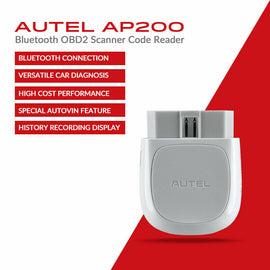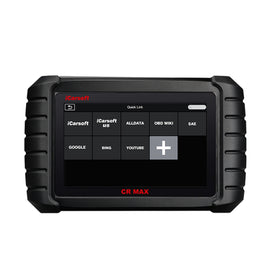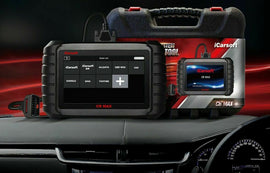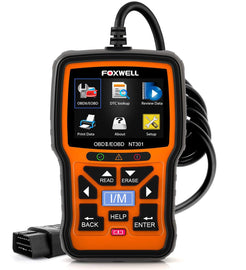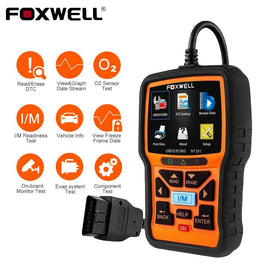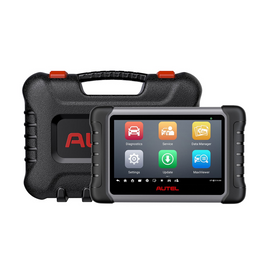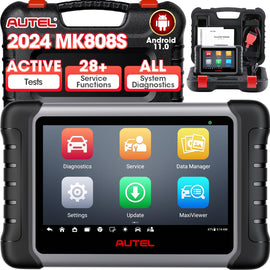When the engine light is on or the car is behaving in any other way. Most people think of checking the basics, and then they get the diagnosis. However, with the OBD 2 scanners offering DTCs, this job becomes easier. However, not every scanner can tell you all.
Usually connected to the OBD port, a simple auto scanner or OBD-II code reader reports fault codes about the engine and emissions (powertrain) systems.
On the other hand, advanced automotive diagnostic or scan tools have access to a broader range of systems and code types, including manufacturer-specific codes, chassis and body system issues, and other subsystems.
Buyers can select the best car diagnostic scan tool, whether it's a high-end professional unit or a basic OBD2 scanner for car owners, by being aware of these differences.
Understanding OBD-II Code Types
The car's computer sends out standardised five-character messages known as OBD-II codes.
The system is denoted by the first letter (P for powertrain, B for body, C for chassis, and U for network).
The code's generic or manufacturer-specific status is indicated by the first digit (0 or 1).
While codes starting with P1 (like P1101) are specific to each automaker, codes like P0420 are generic powertrain codes (typically for 'catalyst efficiency below threshold').
Generally speaking, codes that start with P0xxx are 'generic' (meaning the same thing on all makes), while P1xxx are manufacturer-specific.
You can better interpret what automotive diagnostic tools show if you know the OBD2 scanner code types and the structure of car diagnostic tool codes (e.g., P0xxx vs. P1xxx, or C0xxx vs. C1xxx).
What Basic Auto Scanners Can Handle?
A basic auto scanner can help you with basic functions like:
-
Read and clear engine/emission codes. Simple scanners can retrieve and clear OBD-II trouble codes, primarily powertrain codes such as P0xxx. They deal with common emissions codes and check-engine problems.
-
Reset the check-engine light. Usually, clearing stored codes resets readiness monitors and turns off the Malfunction Indicator Light (MIL).
-
Show simple live data. Many simple code readers display a few live engine parameters, such as RPM, coolant temperature, and fuel trim. They may also display freeze-frame images of the situation at the time of the fault.
-
Limited system coverage. They don't read body/chassis codes (B/C) or proprietary manufacturer modules; they typically only access the engine (powertrain) module and occasionally the transmission.
Basic readers are inexpensive and simple to use in real life. For a precise fault description, they frequently only display a numerical code and require an external lookup.
These readers are adequate for handling basic 'check engine' issues for the majority of auto owners.
Advanced Diagnostic Tools
Advanced car diagnostic tools offer complete professional diagnostics:
-
Full system access. These tools can read all vehicle modules' pending, generic, and manufacturer-specific codes. They can identify issues with ABS, airbags (SRS), transmissions, body electronics, and other components because they support a variety of OBD-II protocols and frequently different car brands.
-
Live data logging and graphing. They can graph data streams, record real-time sensor data from any module, and replay logs to look into sporadic problems.
-
Bidirectional controls and coding. High-end tools can perform modifications or reprogramming and send commands into the car, such as turning on the cooling fan or activating a solenoid. They can program keys or calibrate new camshaft sensors, for instance, tasks that a basic reader is unable to perform.
-
Multi-module diagnostics. Advanced scanners can handle complicated systems like transmissions, TPMS (tyre pressure), and sophisticated driver-assist systems in addition to engine codes. They can also reset ABS brakes, airbag lights, and oil service lights.
-
Integrated help and updates. Many can update from OEM databases and come with built-in repair advice and code definitions. While a code reader only displays a code number, this guidance helps technicians diagnose issues.
The cost of these car diagnostic tool features is higher. According to one review, advanced tools are 'on steroids' in comparison to handheld readers, but they are also heavy and costly. The ability to read every DTC, including those specific to a make or model, makes an advanced scanner invaluable for shops and serious do-it-yourselfers.
Advanced OBD-II tools can actually 'read manufacturer-specific DTCs beyond the thousands of generic fault codes' and even carry out complex operations like ECU reflashing.
Comparing Basic Vs. Advanced Auto Scanners
|
Feature |
Basic Auto Scanner |
Advanced Auto Scanner |
|
System Access |
Engine/Powertrain only |
All systems: Engine, ABS, Airbags, Transmission, etc. |
|
Code Types Read |
Generic OBD2 codes (e.g. P0xxx) |
Generic + Manufacturer-specific codes (P1xxx, B/C/U codes) |
|
Live Data Support |
Limited (RPM, temp, etc.) |
Full live data + graphing and logging |
|
Bi-directional Testing |
Not supported |
Supported (e.g. test actuators, sensors) |
|
Service Functions |
Basic (reset check engine light) |
Advanced (oil reset, EPB, key programming, etc.) |
|
Ease of Use |
Plug-and-play, beginner-friendly |
A more complex interface requires technical know-how |
|
Price Range |
$20 – $80 |
$300 – $2000+ depending on features |
|
Best For |
DIY car owners |
Mechanics, workshops, and automotive professionals |
Choosing the Right Scanner
Your use case will determine what vehicle diagnostic tool is best for you. A basic code reader is sufficient for the majority of regular car owners. These inexpensive auto diagnostic tools can read engine trouble codes, reset the check-engine light, and meet the majority of do-it-yourself requirements. A simple OBD2 reader is frequently the best option for a car diagnostic scan if you have a limited budget or only need to fix check-engine problems.
Experts or enthusiasts who own multiple cars may require a more costly tool. Advanced scanners (or OBD-II software with an adapter) can support a wider range of brands and systems. For example, mechanics often purchase scanners that cover airbags, ABS brakes, and manufacturer codes because these tools speed up diagnosis and eliminate trial-and-error repairs.
Conclusion
Choosing the right diagnostic scan tool for Australian cars depends on your level of expertise and the type of issues you need to address. While basic OBD2 scanners are perfect for everyday car owners handling engine light problems, advanced tools are ideal for professionals needing deep diagnostics, bi-directional control, and full-system access.
At Auto Lines Australia, we provide a wide range of auto diagnostic tools—from budget-friendly readers to advanced scanners—tailored for Australian vehicles.
Whether you're a DIY enthusiast or a seasoned mechanic, we ensure you have the right tool to diagnose with confidence and accuracy.
FAQs
1. What codes can a basic OBD2 scanner read?
A basic OBD2 scanner can read generic powertrain codes (P0xxx), mainly related to engine and emissions. It helps identify check engine light issues but doesn’t access manufacturer-specific, body, chassis, or advanced vehicle systems.
2. Can advanced car scanners read manufacturer codes?
Yes, advanced car scanners can read both generic and manufacturer-specific codes, including body (B), chassis (C), and network (U) systems. They offer deeper diagnostics for complex issues and support multiple vehicle brands and control modules.
3. Do I need a professional scan tool for all trouble codes?
Not always. For basic engine faults, a simple scanner works. But to access full-system diagnostics—including ABS, airbags, and custom modules—you’ll need a professional scan tool, especially for accurate repairs or advanced troubleshooting.


